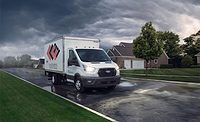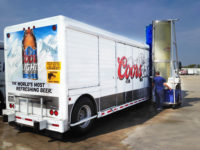Beverage fleets increasingly employ vans, non-CDL trucks
Delivery truck trend reflects driver shortage, sustainability

Beverage distributors, regardless of size, recently have been thinking smaller. Especially with the nationwide CDL driver shortage, beverage fleets now are getting creative with the types of applications for which they deploy lighter, non-CDL-required vehicles — whose sizes range from the smallest cargo vans, pick-up trucks and SUVs to 6- and 8-bay bobtails.
Sports complexes tend to be demanding venues, so it’s quite common for Houston’s Silver Eagle Distributors to use cargo vans to service such sites. “Minute-Maid Park, Reliant Stadium, Toyota Center and so on require a significant amount of services that require both product and supplies to adequately meet their needs,” says Ed Pritchard, senior vice president of fleet managing and purchasing at Silver Eagle. “That’s not to say we don’t make deliveries with the big trucks, but the small half- to 1-ton cargo vans are the day-to-day norm.”
At last count, the Houston AB InBev wholesaler had nearly 70 such vans in its fleet — and that number likely will continue to grow, Pritchard notes.
To get many hot-shot-type deliveries to retail, Silver Eagle uses small, 6- and 8-bay bobtail trucks. The distributor also uses those vehicles to handle any in-route product transfers.
“Essentially our smaller units will connect with the big trucks out on the route,” Pritchard explains. “Transfers will take place and the smaller units will break off and handle deliveries to accounts where the bigger trucks either can’t get into or there is no room to park for delivery execution.”
The 6- and 8-bay bobtails, as well as the cargo vans, also are the vehicles of choice for deliveries to special events. Pritchard notes that many of the special events that Silver Eagle supplies take place in inner-city locations that don’t allow enough room to stage larger trucks. The Silver Eagle fleet includes 12 of the non-CDL side-loaders.
Non-CDL 8- and 4-bays, as well as 1-ton vans make up about 20 percent of Orion, Mich.-based Powers Distributing’s fleet. For the MilerCoors distributor, these vehicles come in handy for hot-shot deliveries for large customers caught short or to handle ordering/loading errors, as well as for special events that take place in non-traditional retail licenses.
“They give us more flexibility and freedom,” says Gary Thompson, executive vice president and general manager at Powers.
Powers also uses the smaller trucks as support vehicles to regular routes, carrying stops out to drivers with full trucks. Typically drivers-in-training will be behind the wheels of those, Thompson notes.
Additionally, Thompson says the vehicles “provide a manner of training drivers, they can go places where a 22-bay cannot [and] they allow us to share helpers between routes.”
Over in Auburn, Mass., Atlas Distributing deploys an Isuzu NPR 14-foot non-CDL box truck, as well as three 26-foot, traditional-size non-CDL delivery trucks. The beer distributor primarily uses them within its non-alcohol division, enabling the wholesaler to allocate its CDL trucks toward the beer division, which typically involves heavier loads, necessitating the added gross vehicle weight (GVW) of a CDL vehicle.
“We also utilize the Isuzu vehicle for emergency, last-minute deliveries that are needed throughout the day by our customer base,” Atlas Operations Manager Brian Lundberg says. “Emergency needs from a draft standpoint can happen on Thursday or Friday and we want to be sure that we can adequately get those deliveries out for the weekends.”
The traditional non-CDL vehicles have ramps and liftgates for ease of operation, while the smaller Isuzu just has a liftgate, Lundberg notes.
As for the lightest vehicles, Atlas uses those mostly for merchandising purposes — “sales and retail support operations, essentially,” Lundberg says. That fleet consists of Transit and Express vans across both the beer and non-alcohol divisions.
“It is much more sustainable — green, in nature — and reduces cost by saving on gas and mileage,” Lundberg adds. “The team conducts fewer stops than a traditional delivery team, but [they] can also cover more miles in a day depending on whether the area of operation is rural, urban, etc. We have essentially all types of delivery areas to cover within central Massachusetts.”
In the future, beverage distributors should expect more beverage delivery operations to embrace the opportunities that light-duty vehicles offer.
The most recent Beverage Industry Fleet Study found that 56 percent of operators use vans, with an average of four such vehicles per operation. Similarly, 53 percent have pickups in their fleets, with an average of two in each operation. What’s more, vans were the top vehicles beverage fleet managers planned to purchase, with 60 percent of respondents saying they expect to buy them within the next 24 months.
By all indications, the future seems lighter. BI
Looking for a reprint of this article?
From high-res PDFs to custom plaques, order your copy today!





